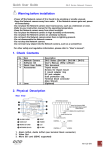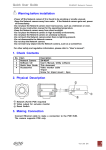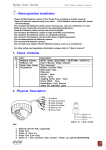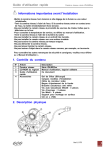Download 1 - CR Kennedy
Transcript
0 Contents 1. PRODUCT FEATURES ......................................................................................................................... 2 2. INSTALLATION ..................................................................................................................................... 3 2.1 INSTALL CAMERA .......................................................................................................................................... 3 2.2 ASSIGN IP ADDRESS .................................................................................................................................. 4 2.3 ACCESS FROM A BROWSER ......................................................................................................................... 4 2.4 ACCESSING THE CAMERA FROM THE INTERNET .......................................................................................... 5 2.5 ADJUSTING THE IMAGE AND FOCUS ............................................................................................................. 5 3. LIVE VIEW ............................................................................................................................................ 6 3.1 VIDEO STREAM TYPES ............................................................................................................................... 6 3.2 HOW TO STREAM H.264 ............................................................................................................................ 7 4. SETUP ................................................................................................................................................... 7 4.1 INSTALL ......................................................................................................................................................... 8 4.1.1 Installation Setup ................................................................................................................................ 8 4.2 VIDEO ........................................................................................................................................................... 8 4.2.1 Codec ................................................................................................................................................... 8 4.2.2 Camera .............................................................................................................................................. 10 4.3 LIVE ............................................................................................................................................................ 12 4.3.1 Viewer Setup ................................................................................................................................... 12 4.4.FTP ............................................................................................................................................................ 13 4.4.1 Config ................................................................................................................................................ 13 4.4.2 Event ................................................................................................................................................. 13 4.4.3 Periodical .......................................................................................................................................... 14 4.5.EVENT ........................................................................................................................................................ 15 4.5.1 Motion ............................................................................................................................................... 15 4.5.2 Mapping ............................................................................................................................................ 16 4.6 NETWROK .................................................................................................................................................. 16 4.6.1 IP setup ............................................................................................................................................ 16 4.6.2 Service Port ..................................................................................................................................... 18 4.6.3 E-mail ................................................................................................................................................ 18 4.7 SYSTEM ..................................................................................................................................................... 19 4.7.1 User ................................................................................................................................................... 19 4.7.2 Date / Time ..................................................................................................................................... 20 4.7.3 Maintenance .................................................................................................................................... 21 4.7.4 Information ....................................................................................................................................... 23 5.DIMENSIONS ....................................................................................................................................... 24 1 1. Product Features The GANZ PixelPro Series (ZN-M2AF) is a high performance H.264 network camera, designed for demanding security installations. It delivers crisp, clear images, disclosing every detail, thanks to its top quality Megapixel progressive CMOS sensor and advanced image processing. Supported by the industry’s largest base of video management software, the GANZ PixelPro provides the perfect solution for securing bank offices, airports and other facilities, and for traffic surveillance, over IP based networks. The optimal Power over Ethernet (IEEE 802.3af) support power to the camera to be delivered via the network, eliminating the need for a power outlet and reducing installation costs. Steady power could be guaranteed with a central Uninterruptible Power Supply (UPS). The GANZ PixelPro offers a comprehensive set of network security and management features. This includes support for port based network control (IEEE802.1X), which allows the camera to be connected to a network secured with this control, and HTTPS encryption, which provides a secure channel between camera and application. It also enables authentication of the video source. Video products are efficiently managed with the powerful GANZ PixelPro Camera Management tool, which is provided on the Installation CD which comes with each GANZ PixelPro camera. 2 1. Network (RJ-45 PoE required) The ZN-M2AF connects to the network via a standard network cable, and automatically detects the speed of the local network segment (10BaseT/100BaseTX Ethernet). This socket must be used to power the ZN-M2AF via Power over Ethernet (PoE). The camera auto-senses the correct power level when using a PoE (Class 2) switch, router or injector. 2. Video output for service monitor This analog video output is available when installation mode is set to ON. Use accessory cable to video output. 3. Reset Switch This switch has 3 functions by pressing time. 1) Switch NTSC / PAL format (less than 1second) 2) System reboot (around 5 seconds) 3) Factory Default Reset (More than 10 seconds) 2. Installation 2.1 Install camera 1) Assembly the bracket for fixing with wall bracket on Camera with supplied screws. 2) Fix the wall bracket on place that user want to install. 3) Connect the Wall bracket and Camera 3 2.2 Assign IP address The default setting of the camera is set “DHCP” to ON. If you have a DHCP server on your network and UPnP function enabled on your PC you can find the network camera in “My network”. If a DHCP server is not available on your network, please assign IP address by the following process. Execute PixelPro_Discovery_Tool.exe. It will search cameras on the network automatically. 1) After the camera is listed in camera list, select the camera. 2) Type in the all network information. 3) Click “Apply” button The GANZ PixelPro can be accessed with most standard operating systems and browsers. The recommended browser is Internet Explorer 7 and above for Windows. 2.3 Access from a browser 4 1. Start a browser (Internet Explorer) 2. Enter the IP address or host name of the camera in the Location/Address field of your browser. Press Enter. 3. Login dialog will appear when the camera is accessed for the first time. 4. The default user name is ADMIN, and password is 1234. 5. The camera’s Live View page is now displayed in your browser. Note: The layout of the live view page in the camera may have been customized to meet specific requirements. Consequently, some of the examples and functions featured here may differ from those displayed on your own Live View page. 2.4 Accessing the camera from the Internet Once installed, the camera is accessible on the local network (LAN). Configure the router/firewall to allow incoming data traffic to access the camera from the Internet. For security reasons this is usually done on a specific port. Please refer to the documentation for router/firewall for further instructions. 2.5 Adjusting the Image and Focus With Analog Video output 1. Open the Live View page in your web browser. - Select the Setup tab, and open the Installation page. - Select the ‘Video Format'. 2. Connect analog monitor to the VIDEO OUT (BNC) on the cable. - Adjust camera angle. With Web Browser 1. Open the Live View page in your web browser. - Select the Setup tab, and open the Video -> Camera page. - Click ‘Lens Adjustment’. 2. Set the desired Zoom position. 3. Click ‘One Push Focus’ button for adjust focus automatically or set focus manually. 5 3. Live View Digital Zoom Snap Shot Full Screen Video Stream change: First stream Ù Second stream Play: Click this button by manually to start the stream Stop: Click this button by manually to stop streaming NOTE: It is possible that not all the buttons described below will be visible unless the Live View page has been customized to display them. 3.1 Video Stream types H.264 protocols and communication methods • RTP (Real-time Transport Protocol) is a protocol that allows programs to manage the real-time transmission of multimedia data, via unicast or multicast. • RTSP (Real Time Streaming Protocol) serves as a control protocol, to negotiate the type of transport protocol to use for the stream. RTSP is used by a viewing client to start a unicast session. • UDP (User Datagram Protocol) is a communications protocol that offers limited service for exchanging data in a network which uses the Internet Protocol (IP). UDP is an alternative to the Transmission Control Protocol (TCP). The advantage of UDP is that, it is not required to deliver all data and may drop network packets when there is network congestion. This is suitable for live video, as there is no point in retransmitting old information that will not be displayed anyway. • Unicasting is communication between a single sender and a single receiver over a network. This means that the video stream goes independently to each user, and each user gets own stream. A benefit of unicasting is, in case one stream fails, it only affects one user. 6 3.2 How to stream H.264 Deciding on the combination of protocols and methods to use depends on your viewing requirements, and on the properties of your network. Setting the preferred method(s) is done in webpage. RTP+RTSP This method (actually RTP over UDP and RTSP over TCP) should be your first consideration for live video, especially when it is important to always have an up-todate video stream, even if some images are lost due to network problems. This could be configured as multicast or unicast. RTP/RTSP/Unicasting should be used for video-on-demand broadcasting, so that there is no video traffic on the network until a client connects and requests the stream. However, as more and more unicast clients get connected, the traffic on the network will increase and may cause congestion. Although there is a maximum of 10 unicast viewers, note that all multicast users combined count as 1 unicast viewer. RTP/RTSP This unicast method is RTP tunneled over RTSP. This could be used to exploit the fact that it is relatively simple to configure firewalls to allow RTSP traffic. 4. Setup The GANZ PixelPro is configured from the Setup link, which is available on the top left hand side in the web interface. This configuration could be done by: • Administrators, who have unrestricted access to all settings under the Setup tab. Accessing the Setup link from a browser 1. Start your web browser and enter the IP address or host name of the camera into the address bar. 2. The Live View page is now displayed. Click on the Setup tap. 7 4.1 Install 4.1.1 Installation Setup Installation Mode allows use of the analog BNC output from the camera to connect the camera NTSC, PAL: Analog Output is enabled. OFF: Analog output will be disabled. 4.2 Video 4.2.1 Codec This section allows you to choose the compression codec for each of the video streams. 8 Codec H.264 This is a video compression standard that makes good use of bandwidth and could provide high-quality video streams. The H.264 standard provides the scope for a large range of different coding tools for use by various applications in different situations, and the GANZ PixelPro provides certain subsets of these tools. Using H.264, it is also possible to control the bit rate, which in turn allows the amount of bandwidth usage to be controlled. CBR (Constant Bit Rate) is used to achieve a specific bit rate by varying the quality of the H.264 stream. While using VBR (Variable Bit Rate), the quality of the video stream is kept as constant as possible, at the cost of a varying bit rate. Motion JPEG This format uses standard JPEG still images in the video stream. These images then are displayed and updated at a rate sufficient to create a stream that shows constantly updated motion. The Motion JPEG stream uses considerable amounts of bandwidth, but also provides excellent image quality and access to every individual image contained in the stream. Multiple clients accessing Motion JPEG streams could use different image settings. Size Video output resolution. See the next page for the output resolution table. Frame rate 1 ~ 30fps (60Hz) / 1 ~25fps (50Hz) GOP Size 1 ~ 60 frames Bit-rate control (CBR or VBR) When using H.264 compression, if there is only limited bandwidth available, a constant bit rate (CBR) is recommended, although this may compromise image quality. Use a variable bit rate (VBR) for the best possibly image quality. Average Bit-rate (512Kbps ~ 10Mbps) Recommended bit rate for D1 or VGA : 800Kbps ~ 1Mbps Recommended bit rate for 1.3M (720p) : 3Mbps ~ 4Mbps Recommended bit rate for 2.0M (1080p) : 6Mbps ~ 8Mbps Quality 1 ~ 100 This parameter will be available in MJPEG mode. Anti-Flicker mode (Flicker less mode) 60Hz / 50Hz Video Mirroring Select Video Mirroring mode NONE/ HORIZONTAL / VERTICAL / FLIP(H+V) 9 < Output resolution and Frame rate table for ZN-M2AF > Second Stream 720p 4CIF 4CIF* VGA 4:3 VGA 16:9 VGA* 16:9 CIF QVGA 1280x720 704x480 704x576 640x480 640x360 640x352 352x240/288 352x240 1920x1080 N/A 24 24 25/30 25/30 25/30 25/30 25/30 1280x1024 N/A 25/30 25/30 25/30 25/30 N/A 25/30 25/30 1024x768 N/A 25/30 25/30 25/30 25/30 N/A 25/30 25/30 1280x720 25/30 25/30 25/30 25/30 25/30 N/A 25/30 N/A 704x480 N/A 25/30 N/A 25/30 25/30 N/A 25/30 N/A 704x576 N/A N/A 25/30 25/30 25/30 N/A 25/30 N/A 640x480 N/A N/A N/A 25/30 N/A N/A N/A 25/30 640x360 N/A N/A N/A N/A 25/30 N/A N/A 25/30 352x240/288 N/A N/A N/A N/A N/A N/A 25/30 N/A 320x240 N/A N/A N/A N/A N/A N/A N/A 25/30 RESOLUTION Table 1080p SXGA XGA 720p 4CIF First Stream 4CIF* VGA 4:3 VGA 16:9 CIF QVGA Unit : fps 4.2.2 Camera This section allows you to adjust various camera settings. 10 Exposure Control Exposure Mode AUTO: Use this setting for automatic exposure control. MANUAL: Use these settings to control camera exposure manually. To compensate for poor lighting conditions, you can adjust the Color level, Brightness, Sharpness, Contrast and Exposure control. NOTE: When AE is enabled, some of the submenus (AGC Gain, e-Shutter Speed) will be disabled. AGC Gain 0 ~ 36 dB Slow shutter mode For low light conditions, turn on slow shutter mode. Max AGC Gain LOW / HIGH selectable. BLC Control (Back Light Compensation) The BLC adjusts the exposure of scenes with strong backlight in the center-bottom of the image. When the image background is too bright, or the subject too dark, backlight compensation makes the subject appear clearer. The settings for low light behavior determine how the camera behaves sat low light levels. These settings affect video image quality and how much noise is in the images. Day & Night Control Day & Night Mode Auto / Day / Night Set this filter to OFF to allow the camera to 'see' infrared light, removing the IR cut filter, when using an IR illuminator. This will make the image clearer. If set to Auto, the camera will automatically switch between IR cut filter On and Off, according to the current lighting conditions. 0 / 5 /10 /15 / 30 / 60 sec Set detection window time in order to avoid failure switching. White Balance Control WB Mode AUTO : (Automatic White balance) MANUAL : (Manual White balance) The White balance adjustment setting is used to make the colors in the image appear consistent, compensating for the different colors present in different light sources. The GANZ PixelPro camera can be set to automatically identify the light source and compensate for its color temperature. If necessary, the type of light source could be set manually. 11 Image Property Control Modify the video signal parameters, such as: Brightness, Sharpness, Contrast, and Color. Sharpness (Default: 8, Range: 1~15) Brightness (Default: 15, Range: 0~30) Contrast (Default: 15, Range: 0~30) Color (Default: 15, Range: 0~30) 4.3 Live GANZ PixelPro can support up to 10 simultaneous users via unicast. 4.3.1 Viewer Setup Live View Protocol RTP Unicast (UDP) / RTP over RTSP (TCP) Buffering Time (frame based) Determines (0 ~ 90) x 1/30 sec (0 ~ 3sec) Viewer OSD Setup Date: Determines whether the date is displayed. Resolution: Determines whether the camera resolution is displayed. Event State: Determines whether the event state is shown on display window. Event State: (as shown in Live View) M : Motion 12 4.4.FTP 4.4.1 Config Server Configuration Allows transmission of still images to remote sites, using the FTP server. Set the information for FTP transmission by inserting the IP address, Username and Password of the remote FTP Server. 4.4.2 Event Event FTP Sending You can configure the camera to upload still images to FTP server based on event such as Motion detection. Directory The name of the directory where the still images will be stored when an Event occurs. File Prefix You may add a file name prefix to the stored image file name. Example: If the file prefix is ‘MVD’, the still image would be saved as MVD_date_time.jpg. 13 FTP Send Mapping Choose which types of events will be recorded to the FTP server by checking the desired event. Effective Period This parameter lets you decide whether to save all the events that are happening at all hours of the day, or only the events that occur within during specific times of the day. The Schedule method is used to save events into the FTP server during a specific time range. The start time and the end time can be set using the dropdown list. 4.4.3 Periodical Periodical FTP Sending It allows transmission of still images periodically to the FTP server. Directory The name of the directory where the still images will be stored. File Prefix You may add a file name prefix to the stored image file name. Example: If the file prefix is ‘per’, the still image would be saved as per_date_time.jpg. Interval It allows for saving still images based on frequency (1 image every 10 sec, for example). Use the drop-down control to set from 10 seconds to 1 hour. Effective Period This parameter lets you decide whether to save still images at all hours of the day, or within during specific times of the day. 14 4.5.Event 4.5.1 Motion Motion Detection Motion detection is used to generate an alarm whenever movement occurs within the video image. A total of 4 motion detection zones can be configured. Configuring Motion Detection 1. Click Motion Detection in the Event Config menu. 2. Select an area for motion detection from Area 1 to Area 4. 3. Select boxesof the motion detection zone you are creating. 4. Adjust sensitivity level. 5. Click Save. NOTE: Using the motion detection feature will consume more of the cameras resources, and this could decrease the camera’s overall performance, depending on your settings. 15 4.5.2 Mapping Event Mapping It is possible to define conditions that would cause the camera to respond with certain actions. A triggered event happens as a result of an event which is mapped within this menu. This could be caused by motion detection or an external alarm input. E-mail notification could be sent by Motion Event. 4.6 Netwrok 4.6.1 IP setup IP Address Configuration The IP address could be set automatically via DHCP, or a static IP address could be set manually. NOTE: IP address assignment via DHCP may lead to the situation where the IP address changes and you lose contact with the camera. If your DHCP server can update a DNS server, you can access the GANZ PixelPro by a static host name, regardless of having a dynamic IP address. Configure the options for notification of IP address change (under Services) to receive notification from the camera when the IP address changes. 16 DNS Configuration DNS (Domain Name Server) provides the translation of host names to IP addresses on your network. Primary DNS server Enter the IP address of the Primary DNS server for your network. Secondary DNS server Enter the IP of the Secondary DNS, which is used if the Primary DNS server is unavailable. How to assign IP address by PixelPro Discovery tool Execute the PixelPro Discovery Tool (from the Installation CD). on the network automatically. It will search cameras 1) After the list of detected devices appears, select the camera you are trying to configure. 2) Enter all of the network information for your camera. 3) Click “Apply” button. When you double-click the camera within the list, the default web browser (Internet Explorer, or compatible equivalent) will open and automatically connect to the camera. 17 4.6.2 Service Port Service Port HTTP port The default HTTP port number (80) could be changed to any port within the valid port range (1-65535). This is useful for simple port mapping. RTSP port The RTSP protocol allows a connecting client to start an H.264 stream. Enter the RTSP port number to use. The default setting is 554. NOTE: After changing the default port numbers, the user can use the ‘PixelPro Discovery Tool’ to search and connect automatically if they can’t remember the specific port numbers that they used. 4.6.3 E-mail 18 You must turn Notification to ‘On’ and then enter the host names or addresses for your mail servers in the fields provided, to enable the sending of event and error email messages from the camera to predefined addresses via SMTP. Note1) Frequency : Mail server may register the sender to SPAM list when frequency is set to “1 Min”. It may be better to set “5 Min” for safe side. Note2) From : Specify the name who sent e-mail notification. It may be better to use email format like as [email protected]. Some e-mail server will refuses it. 4.7 System 4.7.1 User When you access the camera, the Configure Root Password dialog box appears. Enter the user name ADMIN and password 1234 to log in. To change the password or add a user, go to Setup > System > User. Fill in the User ID, Password and E-mail address. Select the Group. Then press the ‘ADD’ button and click ‘SAVE’. NOTE: The default administrator username ADMIN is permanent and cannot be deleted or altered. 19 4.7.2 Date / Time Date & Time Format Specify the formats for the date and time (12h or 24h) displayed in the Live View video streams. NTP Server Synchronize the time from an NTP server every 60 minutes. Specify the IP address or host name of the NTP server you are using. Local Time / PC Sync/SAVE Specify Local time manually or Synchronize to PC time automatically. Time Zone Setup You may select your time zone from the drop-down list. D.S.T (Daylight Saving Time) Toggle automatic DST clock adjustment on/off. 20 4.7.3 Maintenance System Name Choose a system name to identify the camera when using e-mail notifications. System Reboot Reboots the camera. Factory Default To reset the camera back to the original factory default settings. Firmware Update From time to time, CBC will release firmware updated for the PixelPro Series camera, which will contain feature additions and other improvements. Always read the upgrade instructions and release notes that accompany each new firmware release, before updating the firmware. NOTE: Preconfigured and customized settings should be saved before the firmware is upgraded. 21 Firmware Update Procedure 1. Save the firmware file to your computer. 2. Go to Setup > System > Maintenance within the camera web browser setup. 3. In the Firmware Update section, browse to the desired firmware file on your computer. Then Click OK. NOTE: Do not disconnect power to the unit during the upgrade. The unit will restart automatically after the upgrade has completed. (1~5 minutes) 4. If you suspect the firmware upgrade for the camera has failed, always wait at least 5-10 minutes before restarting the upgrade process. 5. CBC reserves the right to charge for any camera repair which can be attributed to faulty upgrading by the user. Always read the upgrade instructions and firmware release notes before updating the firmware. System Reboot There are two ways to reset the camera. Case 1) Using the web browser: 1. Go to SETUP > System > Maintenance. 2. Click “System Reboot Button” and wait 1 minute for camera to reboot. Case 2) Using the Reset Button of the camera: 1. Press and keep for 5 seconds than release the button. Factory Default Reset There are two ways to reset the camera back to factory default. Case 1) Using the web browser: 1. Go to SETUP > System > Maintenance. 2. Click Factory Default Button . Case 2) Using the Reset Button of the camera: 1. Push & hold the reset button more than 10 seconds. 2. Release the reset button. NOTE: The unit will now have the default IP address from a DHCP server. Use the ‘PixelPro Discovery Tool’ to discover and connect to the camera. 22 4.7.4 Information System Information You can confirm the system information of the camera. F/W version / Model Name / MAC address / IP address settings 23 5.Dimensions 24 25 26 27











































